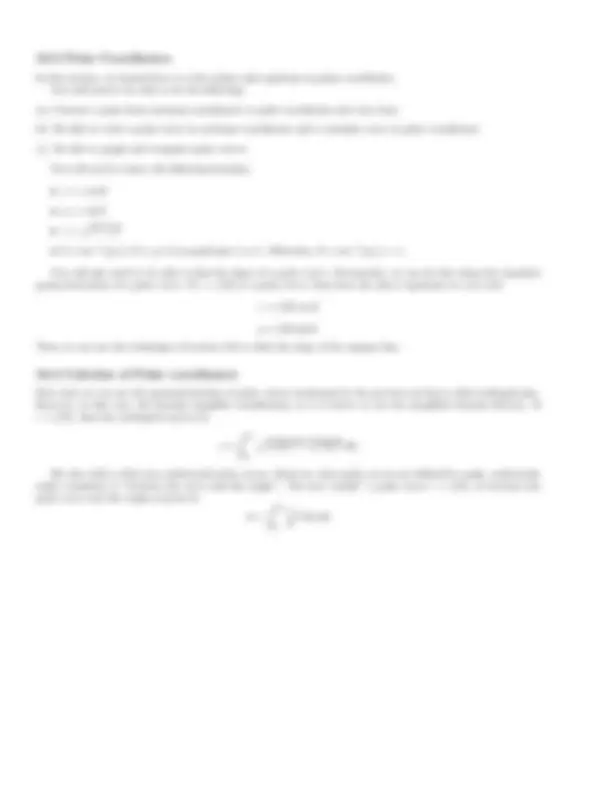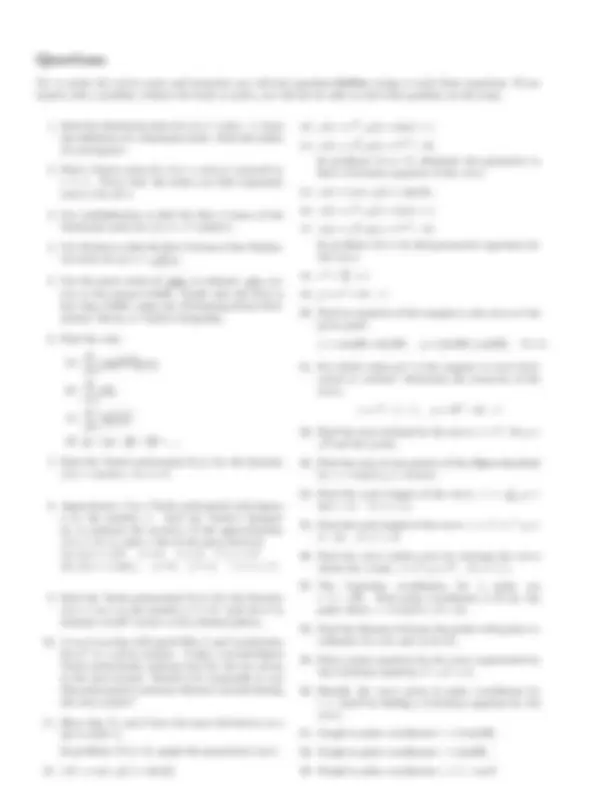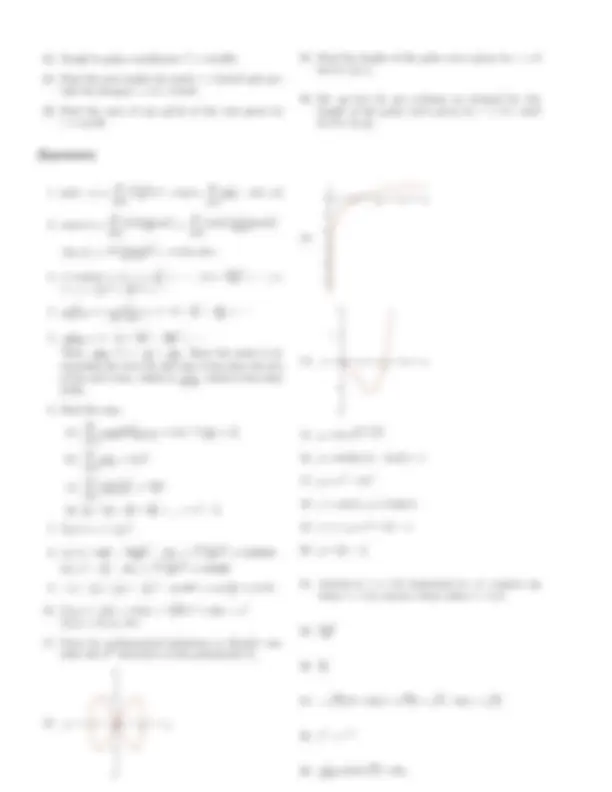





Study with the several resources on Docsity

Earn points by helping other students or get them with a premium plan


Prepare for your exams
Study with the several resources on Docsity

Earn points to download
Earn points by helping other students or get them with a premium plan
Community
Ask the community for help and clear up your study doubts
Discover the best universities in your country according to Docsity users
Free resources
Download our free guides on studying techniques, anxiety management strategies, and thesis advice from Docsity tutors
(c) Be able to graph and recognize polar curves. You will need to know the following formulas: • x = r cos θ. • y = r sin θ. • r = √x2 + y2.
Typology: Lecture notes
1 / 6

This page cannot be seen from the preview
Don't miss anything!




The Final Exam is comprehensive. You should refer to prior reviews when studying material in chapters 6, 7, 8, and 11.1-9. This review will cover 11.10-11 and chapter 10. This sheet has three sections. The first section will remind you about techniques and formulas that you should know. The second gives a number of practice questions for you to work on. The third section gives the answers of the questions in section 2.
Finding a power series that represents a specific function is the next topic. The first one we learned was the geometric series: 1 1 − x
n=
xn^ iff x ∈ (− 1 , 1).
We then found the sum of several series by differentiating, integrating, multiplying by x, etc. The Taylor series of a function is ∑∞
n=
f (n)(c) n! (x − c)n
and can also be used to find the power series of a function. Notice that the interval of convergence of these series is still very important. We need to know when we can trust them. In addition to the geometric series above, the following Maclaurin series (with interval of convergence) are important:
n=
(−1)nx^2 n+ 2 n + 1
n=
(−1)nxn+ n + 1
n=
xn n!
n=
r n
xn, (− 1 , 1) where the binomial
coefficients are
(r n
= r(r−1)··· n(!r−n+1)
n=
(−1)nx^2 n+ (2n + 1)!
n=
(−1)nx^2 n (2n)!
n=
x^2 n+ (2n + 1)!
n=
x^2 n (2n)!
If you need to construct a Maclaurin series of a function and some of the above functions are included, it is almost always easier to manipulate the Maclaurin series instead of constructing the series by scratch.
In addition to finding whether sums of series converge or not, we also were able to find approximations to the error. There were 3 basic approximations to the error given by the Integral test, Alternating Series test, and the Taylor Series.
ak is convergent with sum s and f (k) = ak where f is a continuous, positive, and decreasing function for x ≥ n, then the remainder Rn = s − sn =
k=n+
ak satisfies the inequality
∫ (^) ∞
n+
f (x) dx ≤ Rn ≤
n
f (x) dx
(−1)kak is convergent with sum s and the remainder Rn = s − sn =
k=n+
(−1)kak satisfies the inequality
|Rn| < an+
∑n k=
f (k)(c) k! (x^ −^ c)
k (^) is the nth Taylor polynomial of f (x) centered at c, then
the remainder Rn(x) = f (x) − Tn(x) satisfies the inequality
|Rn(x)| ≤
(n + 1)!
|x − c|n+
on the interval where |f (n+1)(x)| < M. We use this information, when applicable, to find maximum errors when approximating a function by a Taylor polynomial as well.
We learned how to define curves parametrically. That is, we learned how to describe a curve given by an equation H(x, y) = 0
in terms of a pair of functions x = f (t), y = g(t). You will need to be able to do the following: (a) Graph a curve from its parametric equations.
(b) Recognize the curve of a set of parametric equations.
(c) Eliminate the parameter of the parametric equations to find an equation in x and y describing the curve.
(d) Construct a set of parametric equations for a curve written in cartesian coordinates.
In the discussion below, we will assume that a curve can be described parametrically by
x = f (t), y = g(t). Slopes dy dx
dy dt dx dt
g′(t) f ′(t)
This gives a formula for the slope as a function of parameter.
d^2 y dx^2
d dt
dy dx
dx dt Arclength s =
∫ (^) t 1
t 0
(f ′(x))^2 + (g′(x))^2 dx
Surface Area Rotated about the x axis: S =
∫ (^) t 1
t 0
2 πf (x)
(f ′(x))^2 + (g′(x))^2 dx
Rotated about the y axis: S =
∫ (^) t 1
t 0
2 πg(x)
(f ′(x))^2 + (g′(x))^2 dx
Area under the curve Area between the curve and the x axis:
A =
∫ (^) t 1
t 0
y dx =
∫ (^) t 1
t 0
g(t)f ′(t) dt
Area between the curve and the y axis:
∫ (^) t 1
t 0
x dy =
∫ (^) t 1
t 0
f (t)g′(t) dt
Try to study the review notes and memorize any relevant equations before trying to work these equations. If you cannot solve a problem without the book or notes, you will not be able to solve that problem on the exam.
2 cos x− 1.
(a)
n=
(−1)n ( √ 3)^2 n+1(2n+1)
(b)
n=
3 2 nn!
(c)
n=
(−1)nx^2 n (2n+1)!
(d) (^) 2!^4 + (^) 3!^8 + (^16) 4! + (^32) 5! + ....
x, a = 8, n = 2, 7 ≤ x ≤ 9 (b) f (x) = x sin x, a = 0, n = 4, − 1 ≤ x ≤ 1
t, y(t) = t^3 /^2 − 2 t. In problems 15 to 17, eliminate the parameter to find a Cartesian equation of the curve.
t, y(t) = t^3 /^2 − 2 t. In problems 18 to 19, find parametric equations for the curve
2 4 = 1
x = cos(3θ)+sin(2θ), y = sin(3θ)+cos(2θ); θ = 0
x = t^2 − t − 1 , y = 2t^3 − 6 t − 1
3). Find polar coordinates (r, θ) for the point where r > 0 and 0 ≤ θ < 2 π.
n=
f (n)(0) n! x
n (^) = ln 2 + ∑∞ n=
−xn 2 nn : (R^ = 2)
n=
f (n)(1)(x−1)n n! =^
n=
(−1)n+1π^2 n(x−1)^2 n (2n)!
|Rn(x)| ≤ π
n+1|x− 1 |n+ (n+1)! →^ 0 for all^ x
2 2! +^ · · ·^.. .)(1 +^
(2x)^2 2! +^ · · ·^ ) = 1 + x + 52 x^2 + 136 x^3 + · · ·
2 cos x− 1 =^
x^2 − x2!^2 + x4!^4 −··· = − 2 − x
2 6 −^
x^4 120 +^ · · ·
2 9 −^
14 x^3 81 +^ · · · Thus, √ (^311). 1 ≈ 1 − 301 + 4501. Since the series is al- ternating the error for this sum is less than the size of the next term, which is 405007 , which is less than 0 .001.
(a)
n=
(−1)n ( √ 3)^2 n+1(2n+1) = tan
π 6
(b)
n=
3 2 nn! = 3
e
(c)
n=
(−1)nx^2 n (2n+1)! =^
sin x x
(d) (^) 2!^4 + (^) 3!^8 + (^16) 4! + (^32) 5! + .... = e^2 − 3
2 288 :^ |R^2 | ≤^
f (3)(7)· 13 3! ≈^0.^00034 (b) x^2 − x
4 6 :^ |R^4 | ≤^
f (5)(1)· 15 5! ≈^0.^0396
′′(0) 2 x
(^2) = 20x + x 2 T 2 (1) = 21 m: No
1 − x^2
√ 2 15
10 /3 + ln(3 +
2 − ln(1 +